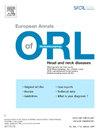Relevance of anatomical remnants for revision sinus surgery
IF 2.4
4区 医学
Q2 OTORHINOLARYNGOLOGY
European Annals of Otorhinolaryngology-Head and Neck Diseases
Pub Date : 2025-03-01
DOI:10.1016/j.anorl.2024.09.009
引用次数: 0
Abstract
Objectives
Review of the scientific literature dedicated to investigating how residual structures impact surgical outcomes in chronic rhinosinusitis (CRS) patients, providing information on the frequency of anatomical remnants after endoscopic sinus surgery (ESS).
Material and methods
This review has been reported following the recommendations of the SWiM guideline. PubMed, Cochrane Library, Embase, and Web of Science were searched until April 2024. Studies selected for the systematic review were assessed about quality and risk of bias using the Oxford Centre for Evidence-Based Medicine Levels of Evidence and STROBE. The findings were analyzed descriptively and qualitatively, aligning with EPOS and ICAR guidelines.
Results
Fourteen relevant studies met the inclusion criteria for qualitative synthesis. Prospective and retrospective cross-sectional designs, focusing on revision ESS, were included. Four studies examined full-house functional ESS (FESS), three focused on frontal sinus surgery, four on conventional FESS and three did not specify the surgery type. The risk of bias was assessed, revealing significant variability in study quality and a low level of evidence. Wide variability was found in anatomical structures remaining after ESS, most notably in retained uncinate process (29.6–64%), agger nasi cell (4.5–83.33%) and frontoethmoidal cells (40.7–96.8%). Observations on concha bullosa, septal deviation and lateralization of the middle turbinate revealed distinct patterns among the included studies.
Conclusion
This systematic review underscores the persistent challenge of incomplete resection of anatomical structures in revision surgeries for CRS. The variability in the retention of key structures highlights the complexity of surgical outcomes and the need for further refinement in surgical techniques.
解剖残留物与鼻窦翻修手术的相关性。
目的:回顾致力于研究残留结构如何影响慢性鼻窦炎(CRS)患者手术效果的科学文献,提供有关内窥镜鼻窦手术(ESS)后解剖残留物频率的信息:本综述根据 SWiM 指南的建议进行报告。对 PubMed、Cochrane Library、Embase 和 Web of Science 进行了检索,检索期至 2024 年 4 月。采用牛津循证医学中心的证据等级和 STROBE 评估了系统综述所选研究的质量和偏倚风险。根据 EPOS 和 ICAR 指南,对研究结果进行了描述性和定性分析:结果:14 项相关研究符合定性综合的纳入标准。这些研究采用了前瞻性和回顾性横断面设计,重点关注修订版 ESS。四项研究检查了全室功能性ESS(FESS),三项研究侧重于额窦手术,四项研究侧重于传统FESS,三项研究未说明手术类型。对偏倚风险进行评估后发现,研究质量存在显著差异,证据水平较低。研究发现,ESS术后残留的解剖结构存在很大差异,最明显的是保留的弓形突(29.6%-64%)、agger nasi细胞(4.5%-83.33%)和前齿状突细胞(40.7%-96.8%)。在纳入的研究中,对中鼻甲圆锥体、鼻中隔偏曲和侧位的观察显示了不同的模式:本系统综述强调了在 CRS 翻修手术中解剖结构切除不彻底这一长期存在的难题。关键结构保留的差异性凸显了手术结果的复杂性以及进一步完善手术技术的必要性。
本文章由计算机程序翻译,如有差异,请以英文原文为准。
求助全文
约1分钟内获得全文
求助全文
来源期刊

European Annals of Otorhinolaryngology-Head and Neck Diseases
OTORHINOLARYNGOLOGY-
CiteScore
3.70
自引率
28.00%
发文量
97
审稿时长
12 days
期刊介绍:
European Annals of Oto-rhino-laryngology, Head and Neck diseases heir of one of the oldest otorhinolaryngology journals in Europe is the official organ of the French Society of Otorhinolaryngology (SFORL) and the the International Francophone Society of Otorhinolaryngology (SIFORL). Today six annual issues provide original peer reviewed clinical and research articles, epidemiological studies, new methodological clinical approaches and review articles giving most up-to-date insights in all areas of otology, laryngology rhinology, head and neck surgery. The European Annals also publish the SFORL guidelines and recommendations.The journal is a unique two-armed publication: the European Annals (ANORL) is an English language well referenced online journal (e-only) whereas the Annales Françaises d’ORL (AFORL), mail-order paper and online edition in French language are aimed at the French-speaking community. French language teams must submit their articles in French to the AFORL site.
Federating journal in its field, the European Annals has an Editorial board of experts with international reputation that allow to make an important contribution to communication on new research data and clinical practice by publishing high-quality articles.
 求助内容:
求助内容: 应助结果提醒方式:
应助结果提醒方式:


